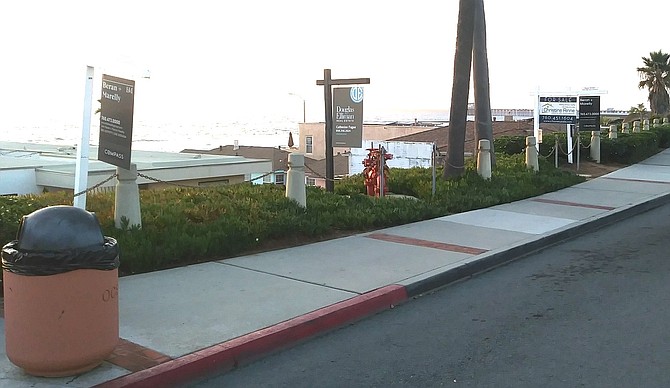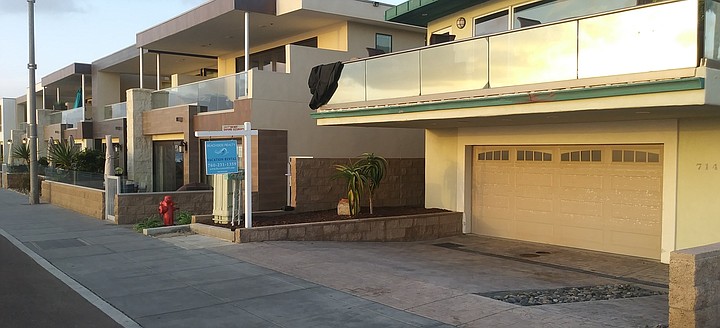 Facebook
Facebook
 X
X
 Instagram
Instagram
 TikTok
TikTok
 Youtube
Youtube

Has the threat of rising tides or the reality of denuded beaches triggered a rush to sell beachfront property in Oceanside?
The Strand is Oceanside’s most traveled seaside roadway. Many of the scenes in TNT’s Animal Kingdom were shot in the beachfront bungalows on The Strand. But is there a new rush to sell them?

A one-mile strip of Pacific Street between Wisconsin Avenue and Tyson Street recently hosted ten realtor signs at one time looking to draw attention to beachfront homes on The Strand down below.
Over the years, The Strand occasionally gets inundated with seawater forcing beachfront homeowners to protect their homes with sandbags. A storm surge coupled with a King Tide condition (an unusually high tide caused by the moon and sun alignment) can be particularly dangerous.
Then there’s the climate change thing. NASA’s head climatologist Dr. James Hansen said a ten-foot sea level rise could arrive in 50 years.
The asking price for one 2916-square foot condo was marked down last month by $1.8-million. The new asking price is $2,595,000.
Oceanside homeowners who live on The Strand do have unique issues. Some have found they have been denied flood insurance. Those beachfront homeowners with subterranean parking can only hope they can keep out the Pacific with bilge pumps faster than the Pacific Ocean wants to come in.
But many local real estate pros contacted for this article say they are not aware of a mass selloff connected with invading seawater.
“Yeah I saw those signs too,” says real estate pro Chris Abad. “I think it might be that the market just reached a high point and people thought this was the best time to sell.” He says another issue may be the difficulty in getting approval to install protective rip rap (boulders) in front of houses to avoid erosion. “You have to go through the Coastal Commission for that, and people may not want to deal with that.”
Real estate agent Bob Botkin says he has four oceanfronts on the market. He says business is booming on the beach, especially in the vacation rental business. “My [owner] in Colorado just took his off the market. He found out he could make $100,000 a year in vacation rentals.” He says ocean water breaching The Strand roadway and soaking homes is a concern. “We had a King Tide last winter and had to use sandbags. Water didn’t get into any of our units but I did hear of one unit that got it.”
Agent Christine Rinne was involved with the sale of a condo on the South 100 block of The Strand. “My client just decided to take it off the market. They were making too much money renting.”
“The market has leveled off a bit,” says one agent who does a lot of business with oceanfront homes but who did want to be named for this article. “There was a tiny fluctuation, but I’m not sensing any kind of panic. Overall the trend along the coast is pretty stable.” She adds that the flooding issue is just something people deal with. “It just brings another level of maintenance.” But she admits some of the homes on The Strand seem to have been designed with a major flaw: parking areas that were built with underground parking areas. “I certainly would not have designed them that way. I can’t even imagine why the city allowed that to happen.”
Jan Dickinson says she has been in the market of selling seaside homes “…for many, many years.” She says Oceanside’s vacation rental market is on fire. She agrees with other realtors that talk of climate change has not affected the market. “My property has flood insurance. But it is my understanding that a lot of properties [on The Strand] can no longer get flood insurance.”
Agent Stormy Rogers says some homes were built with subterranean parking almost 20 years ago, before climate change became front-of-mind. “But the 17 units on the 700 block [of The Strand], they just built those. How did they let that go through?”
Regarding the houses on The Strand that were allowed to be built with subterranean parking spaces, Russ Cunningham, principal planner for the city of Oceanside responds: “I don’t have any background on the Strand project in question.”
Cunningham says a permit from the California Coastal Commission must usually be issued before rip rap/revetment can be installed to save a home from sea damage. But he said the city did allow one homeowner on the 1200 block a city-issued exemption which avoided the Coastal Commission process altogether.
Lifeguards say that anytime there is more than an inch of rain, the southern end of Strand can fill up with water. They have had to rescue some residents from the homes with subterranean parking who got flooded out.
Dr Mark Merrifield, director for the center for Scripps/UCSD’s Climate Change Impacts and Adaptation says he was not aware of any particular issues with North County beaches, “The focus of our research has mostly been with the low-lying areas of Imperial Beach.”


Has the threat of rising tides or the reality of denuded beaches triggered a rush to sell beachfront property in Oceanside?
The Strand is Oceanside’s most traveled seaside roadway. Many of the scenes in TNT’s Animal Kingdom were shot in the beachfront bungalows on The Strand. But is there a new rush to sell them?

A one-mile strip of Pacific Street between Wisconsin Avenue and Tyson Street recently hosted ten realtor signs at one time looking to draw attention to beachfront homes on The Strand down below.
Over the years, The Strand occasionally gets inundated with seawater forcing beachfront homeowners to protect their homes with sandbags. A storm surge coupled with a King Tide condition (an unusually high tide caused by the moon and sun alignment) can be particularly dangerous.
Then there’s the climate change thing. NASA’s head climatologist Dr. James Hansen said a ten-foot sea level rise could arrive in 50 years.
The asking price for one 2916-square foot condo was marked down last month by $1.8-million. The new asking price is $2,595,000.
Oceanside homeowners who live on The Strand do have unique issues. Some have found they have been denied flood insurance. Those beachfront homeowners with subterranean parking can only hope they can keep out the Pacific with bilge pumps faster than the Pacific Ocean wants to come in.
But many local real estate pros contacted for this article say they are not aware of a mass selloff connected with invading seawater.
“Yeah I saw those signs too,” says real estate pro Chris Abad. “I think it might be that the market just reached a high point and people thought this was the best time to sell.” He says another issue may be the difficulty in getting approval to install protective rip rap (boulders) in front of houses to avoid erosion. “You have to go through the Coastal Commission for that, and people may not want to deal with that.”
Real estate agent Bob Botkin says he has four oceanfronts on the market. He says business is booming on the beach, especially in the vacation rental business. “My [owner] in Colorado just took his off the market. He found out he could make $100,000 a year in vacation rentals.” He says ocean water breaching The Strand roadway and soaking homes is a concern. “We had a King Tide last winter and had to use sandbags. Water didn’t get into any of our units but I did hear of one unit that got it.”
Agent Christine Rinne was involved with the sale of a condo on the South 100 block of The Strand. “My client just decided to take it off the market. They were making too much money renting.”
“The market has leveled off a bit,” says one agent who does a lot of business with oceanfront homes but who did want to be named for this article. “There was a tiny fluctuation, but I’m not sensing any kind of panic. Overall the trend along the coast is pretty stable.” She adds that the flooding issue is just something people deal with. “It just brings another level of maintenance.” But she admits some of the homes on The Strand seem to have been designed with a major flaw: parking areas that were built with underground parking areas. “I certainly would not have designed them that way. I can’t even imagine why the city allowed that to happen.”
Jan Dickinson says she has been in the market of selling seaside homes “…for many, many years.” She says Oceanside’s vacation rental market is on fire. She agrees with other realtors that talk of climate change has not affected the market. “My property has flood insurance. But it is my understanding that a lot of properties [on The Strand] can no longer get flood insurance.”
Agent Stormy Rogers says some homes were built with subterranean parking almost 20 years ago, before climate change became front-of-mind. “But the 17 units on the 700 block [of The Strand], they just built those. How did they let that go through?”
Regarding the houses on The Strand that were allowed to be built with subterranean parking spaces, Russ Cunningham, principal planner for the city of Oceanside responds: “I don’t have any background on the Strand project in question.”
Cunningham says a permit from the California Coastal Commission must usually be issued before rip rap/revetment can be installed to save a home from sea damage. But he said the city did allow one homeowner on the 1200 block a city-issued exemption which avoided the Coastal Commission process altogether.
Lifeguards say that anytime there is more than an inch of rain, the southern end of Strand can fill up with water. They have had to rescue some residents from the homes with subterranean parking who got flooded out.
Dr Mark Merrifield, director for the center for Scripps/UCSD’s Climate Change Impacts and Adaptation says he was not aware of any particular issues with North County beaches, “The focus of our research has mostly been with the low-lying areas of Imperial Beach.”
Comments